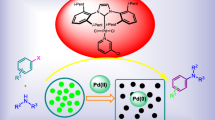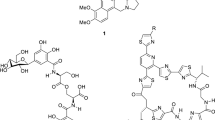Abstract
A dual catalytic system, combing visible light photoredox catalysis and iodide catalysis, has been developed for the functionalization of inert C–H bonds. By doing so, radical allylation reactions of N-aryl-tetrahydroisoquinolines (THIQs) were realized under extremely mild conditions, affording a wide variety of allyl-substituted THIQs in up to 78% yields.
Similar content being viewed by others
References
For selected reviews and books on transition metal catalysis and C–H activation, see: a) HickmanAJ, Sanford MS. Nature, 2012, 484: 177–185
Yeung CS, Dong VM. Chem Rev, 2011, 111: 1215–1292
Ackermann L. Chem Rev, 2011, 111: 1315–1345
Davies HM, Du Bois J, Yu JQ. Chem Soc Rev, 2011, 40: 1855–1856
Yu JQ, Shi ZJ. Topics in Current Chemistry. Heidelberg: Springer, 2010
Dyker G. Handbook of C–H Transformations. Weinheim: Wiley-VCH, 2005
Beller M, Bolm C. Transition Metals for Organic Synthesis: Building Blocks and Fine Chemicals. Vol. 1 and 2. 2nd Ed, Weinheim: Wiley-VCH, 2004
For selected reviews and books, see: a) Zhuo CX, Zheng C, You SL. Acc Chem Res, 2014, 47: 2258–1856
Bandini M. Angew Chem Int Ed, 2011, 50: 994–995
Trost BM, Lee C. Catalytic Asymmetric Synthesis. 2nd Ed. New York: Wiley-VCH, 2010. 593–649
Lu Z, Ma S. Angew Chem Int Ed, 2008, 47: 258–297
Tsuji J. Palladium Reagents and Catalysts: New Perspectives for the 21st Century. Chichester: Wiley, 2004: 431–518
Dai LX, Tu T, You SL, Deng WP, Hou XL. Acc Chem Res, 2003, 36: 659–667
For selected papers on reduction of π-allylpalladium complexes to allylic radicals, see: a) Millán A, Martín-Lasanta A, Miguel D, Cienfuegos LA, Cuerva JM. Chem Commun, 2011, 47: 10470–10472
Millán A, Campana AG, Bazdi B, Miguel D, Cienfuegos LA, Echavarren AM, Cuerva JM. Chem Eur J, 2011, 17: 3985–3994
Campana AG, Bazdi B, Fuentes N, Robles R, Cuerva JM. Angew Chem Int Ed, 2008, 47: 7515–7519
Sasaoka SI, Yamamoto T, Kinoshita H, Inomata K, Kotake H. Chem Lett, 1985, 315–318
For selected reviews, see: a) Narayanam JM, Stephenson CR. Chem Soc Rev, 2011, 40: 102–113
Teplý F. Collect Czech Chem Commun, 2011, 76: 859–917
Shi L, Xia W. Chem Soc Rev, 2012, 41: 7687–7697
Xuan J, Xiao WJ. Angew Chem Int Ed, 2012, 51: 6828-6838
Prier CK, Rankic DA, MacMillan DW. Chem Rev, 2013, 113: 5322–5363
Ravelli D, Fagnoni M, Albini A. Chem Soc Rev, 2013, 42: 97–113
Xi Y, Yi H, Lei A. Org Biomol Chem, 2013, 11: 2387–2403
Schultz DM, Yoon TP. Science, 2014, 343: 1239176
For reviews and books on dual catalysis merging visible light photocatalysis with other catalytic manners, see: a) Hopkinson MN, SahooB, Li J, Glorius F. Chem Eur J, 2014, 20: 3874–3886
Zeitler K, Neumann M. Synergistic visible light photoredox catalysis. In: König B, Ed. Chemical Photocatalysis. Germany: Walter de Gruyter, 2013. 151–168.
For recent examples with palladium catalysis, see: c) Xuan J, Zeng TT, Feng ZJ, Deng QH, Chen JR, Lu LQ, Xiao WJ. Angew Chem Int Ed, 2015, 54: 1625–1628
Lang SB, O’Nele K, Tunge JA. J Am Chem Soc, 2014, 136: 13606–13609.
With gold catalysis, see: e) Hopkinson MN, Sahoo B, Glorius F. Adv Synth Catal, 2014, 356: 2794–2800
Shu XZ, Zhang M, He Y, Frei H, Toste FD. J Am Chem Soc, 2014, 136: 5844–5847.
With nickel catalysis, see: g) Xuan J, Zeng TT, Chen JR, Lu LQ, Xiao WJ. Chem Eur J, 2015, 21: 4962–4965.
With others, see: h) Feng ZJ, Xuan J, Xia XD, Ding W, Guo W, Chen JR, Zou YQ, Lu LQ, Xiao WJ. Org Biomol Chem, 2014, 12: 2037–2040
Bergonzini G, Schindler CS, Wallentin CJ, Jacobsen EN, Stephenson CRJ. Chem Sci, 2014, 5: 112–116
Zou YQ, Lu LQ, Fu L, Chang NJ, Rong J, Chen JR, Xiao WJ. Angew Chem Int Ed, 2011, 50: 7171–7175
Xuan J, Cheng Y, An J, Lu LQ, Zhang XX, Xiao WJ. Chem Commun, 2011, 47: 8337–8339
Zou YQ, Chen JR, Liu XP, Lu LQ, Davis RL, Jørgensen KA, Xiao WJ. Angew Chem Int Ed, 2012, 51: 784–788
Xuan J, Feng ZJ, Duan SW, Xiao WJ. RSC Adv, 2012, 2: 4065–4068
Xuan J, Xia XD, Zeng TT, Feng ZJ, Chen JR, Lu LQ, Xiao WJ. Angew Chem Int Ed, 2014, 53: 5653–5656, and Refs. [3c,3g,3k]
Nguyen JD, D’Amato EM, Narayanam JM, Stephenson CR. Nat Chem, 2012, 4: 854–859
For selected reviews, see: a) Wei Y, Shi M. Acc Chem Res, 2010, 43: 1005–1018
Dai LX, Hou XL. Chiral Ferrocenes in Asymmetric Catalysis: Synthesis and Applications. Weinheim: Wiley-VCH, 2010
List B. Asymmetric Organocatalysis. Heidlberg: Springer, 2010
Denmark SE, Beutner GL. Angew Chem Int Ed, 2008, 47: 1560–1638
Fu GC. Acc Chem Res, 2006, 39: 853–860
Carnes ME, Collins MS, Lindquist NR, Percástegui EG, Pluth MD, Johnson DW. Chem Commun, 2014, 50: 73–75
Patel K, Miljanić OS, Stoddart JF. Chem Commun, 2008, 44: 1853–1855
de Sousa AL, Resck IS. J Braz Chem Soc, 2002, 13: 233–237
Tipson RS, Clapp MA, Cretcher LH. J Org Chem, 1947, 12: 133–138
For detailed condition optimization, including the evaluation of photocatalysts, solvents, light sources and bases, see Supporting Information
General Procedure: In a 10 mL dry flask equipped with magnetic bar was charged with 1 (0.5 mmol, 1.0 equiv.) and Ir(bpy)2(dtbbpy)PF6 (2 mol%), 5 (0.75 mmol, 1.5 equiv.), KI (20 mol%), NaCO2CF3 (1.0 mmol, 2.0 equiv.) and MeCN (5 mL). The mixture was degassed via freeze-pump-thaw method (3 times) and then stirred under the irradiation of 7 W blue LEDs at room temperature for 12 h. The resultant mixture was filtered under vacuum to remove the solid. The filtrate was purified by flash chromatography on silica gel (petroleum ether/DCM=10:1) to afford the desired product 3. Analytical data of 1-allyl-2-phenyl-1,2,3,4-tetrahydroisoquinoline (3a): light yellow oil; 1H NMR (600 MHz, CDCl3) δ (ppm) 7.18 (m, 6H), 6.89 (d, J=8.2 Hz, 2H), 6.73 (t, J=7.1 Hz, 1H), 5.89–5.82 (m, 1H), 5.06 (t, J=13.1 Hz, 2H), 4.74 (t, J=6.7 Hz, 1H), 3.72–3.52 (m, 2H), 3.08–2.96 (m, 1H), 2.88 (dt, J=15.7, 5.2 Hz, 1H), 2.78–2.65 (m, 1H), 2.49 (dt, J=14.1, 7.2 Hz, 1H); 13C NMR (100 MHz, CDCl3) δ (ppm) 149.4, 138.1, 135.6, 134.9, 129.2, 128.5, 127.3, 126.5, 125.7, 117.2, 117.0, 113.8, 59.3, 41.9, 40.9, 27.4; HRMS: m/z (ESI) calculated [M+H]+ 250.1590, measured 250.1594.
Author information
Authors and Affiliations
Corresponding authors
Electronic supplementary material
Rights and permissions
About this article
Cite this article
Feng, Z., Zeng, T., Xuan, J. et al. C–H allylation of N-aryl-tetrahydroisoquinolines by merging photoredox catalysis with iodide catalysis. Sci. China Chem. 59, 171–174 (2016). https://doi.org/10.1007/s11426-015-5548-x
Received:
Accepted:
Published:
Issue Date:
DOI: https://doi.org/10.1007/s11426-015-5548-x




